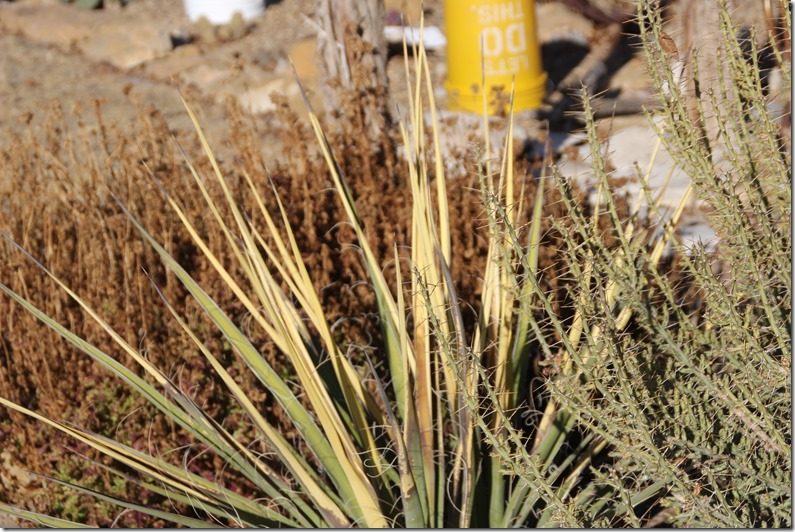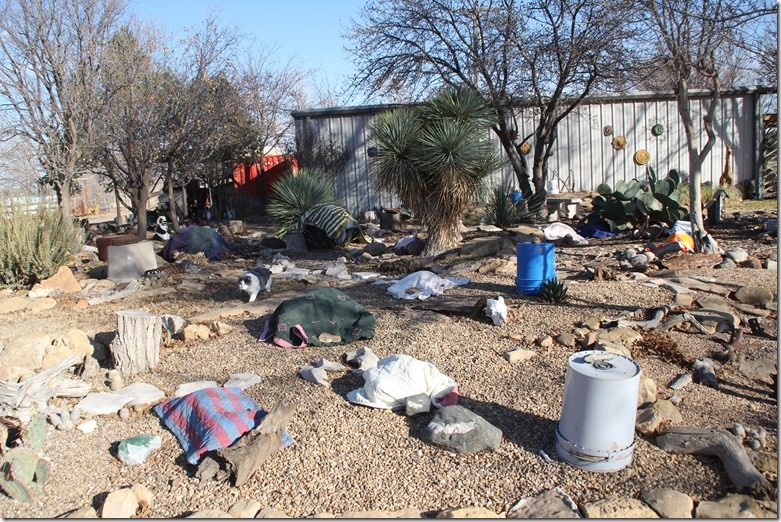The cactus garden looks a mess in winter. The poor cholla and prickly pear do their sad droopy thing. Boxes, gallon cans, and five-gallon buckets stand upside down over plants needing protection; blankets and comforters do the same. Plants that are truly cold-hardy brave the elements and do just fine without protection, but these others need a little help.
I have not uncovered the plants for a couple of days now; the wind is cold enough to be damaging even though the temperature is above freezing during the day. I do need to check to see if the rocks on top of the buckets and cans have kept them in place and reset those that have been blown down. The blankets and comforters tend to stay on, thanks to the sharp ends of the leaves of the agaves piercing the fabric and holding them on.
I have learned through observation over the years that some plants that are supposed to be cold-hardy really do much better with protection during Muleshoe winters. My Agave ovatafolia was managing to survive but showed signs of freeze damage, so about the third year it was here I started covering it. Made all the difference in the world. Same thing with my first Ferocactus hamatacanthus and Trichocereus grandiflorus . The hamatacanthus is the bump in the left of this picture; the trichocereus is the tall clump to the right under the blanket. Both have grown and bloomed so much better after I started covering them in the winter. Now I have three other hamanacanthus under buckets and one small one under a gallon green bean can will continue to get protection as well.
What does frost damage look like, you ask? Here are a few unfortunate examples. This unidentified yucca came from Marfa, and I never cover it because it has always withstood the freezes. Well, not this winter. The hard freeze we had earlier this year did a number on it I was not expecting. It will survive, but it will take time for it to regroup and look good.
This is one of my new Agave montana specimens that is supposed to be cold-hardy, but because this is its first winter with us, I wanted to protect it just in case. Apparently some freezing wind managed to sneak in even though it was covered, so I have been more careful with its cover and even added another layer for more protection. This will not kill the plant, but I will know to be more diligent with its covers in the future.
This one, Agave celsii, bless its heart, had a bucket for cover, but is just not suited for our weather. When it turn to mush like this, it’s a pretty good bet it won’t come back out in the spring, but I keep covering it and will give it time to put up a shoot from its roots before taking it out. If it does come back, it will have to be a container plant so it can be moved inside during the cold months.
A freeze cloth is available for purchase. I bought one two seasons ago; it is still in its wrapper. It is rather thin, I think, and just doesn’t look like it would give the plants enough protection in our winters, so I just keep dragging out the buckets and blankets when cold weather hits. I have written a blog about making comforters into covers for the plants (“Make Your Own Frost Cloth,” January 15, 2019), that you might want to check out if you are interested in making covers for your plants. That story also happens to have pictures of the Agave ovatafolia and Fercactus hamatacanthus uncovered so you can see what those plants look like. Buckets and rigid containers are good if the plant fits under them because it keeps them dry, but even when the blankets, towels, and comforters get wet, they still give effective protection. I do sometimes put a double layer when cloth is involved. Don’t be tempted to put a sheet of plastic over them, though. When plastic gets wet, it freezes and the cold goes right through to the plant, and it might as well not be covered at all.
So if you happen to drive by my house and see the yard all littered with buckets and things, just remember than this spring when you come by, those will all be gone and nice, healthy plants will be growing and getting ready to bloom.
Until then, the geese are keeping watch till warm weather changes the lives of geese and cactus alike.
Around the end of April the buckets and blanket finally come off for good, and things will look considerably different. Then you will have all summer to drive by and see a different landscape. Hope to see you then.












Recent Comments